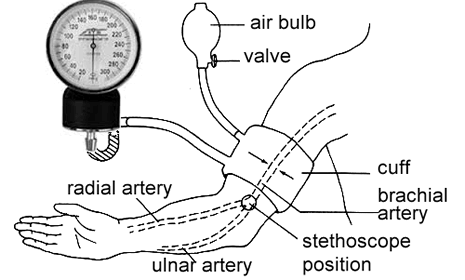Lab: Measuring Heart Rate, Blood Pressure, and Pulse
Measuring Heart Rate Using a Stethoscope
Auscultation of the heart means to listen to and study the various sounds arising from the heart as it pumps blood. The heart sounds may be heard by placing the ear against the chest or by using a stethoscope
Parts of a Stethoscope
Earpieces: Also known as ear tips, these are the components that fit into the user's ears.
Tubing: The tubing of a stethoscope connects the earpieces to the chestpiece.
Chestpiece: This is the central component of the stethoscope that is placed against the patient's body to listen to internal sounds. The chestpiece typically consists of a diaphragm and a bell:
Diaphragm: The diaphragm is the flat, circular part of the chestpiece that is used to detect high-frequency sounds.
Bell: The bell is a smaller, cup-shaped component of the chestpiece that is used to detect low-frequency sounds.
*You can switch between the bell and diaphragm by rotating the stem connected to the chestpiece.
Label the parts of the stethoscope on the image. Use the underlined words.

Procedure: Place the diaphragm of the stethoscope at the center-left of the chest.
Two major sounds can be heard:
First heart sound - Produced at the beginning of systole when the atrioventricular (AV) valves close. This sound has a low-pitched tone commonly termed the “lub” sound of the heartbeat.
Second heart sound - Occurs during the end of systole and is produced by the closure of the semilunar valves and the opening of the AV valves. The sound produced is higher pitched than the first heart sound. It is commonly referred to as the “dub” sound.
*Count the number of beats (lub-dubs) for thirty seconds. Multiply by two to get BPM (beats per minute).
Record data in the table on page 2.
Measuring Pulse
Pulse rate, which refers to the number of times a person's heart beats per minute (bpm), can be
measured using various methods
Measure Using Your Radial Artery

To find your radial artery (the most common point from which people take pulses), hold one hand straight out,elbow bent, palm relaxed and facing up. Raise your thumb slightly skyward to create a small pocket under your thumb at the top of your wrist where you will place the tips of your index and middle finger.
Do not use your thumb--it's also got a pulse and could cause counting confusion.
* Count the beats for 30 seconds and multiply by two. This is your pulse rate. Record data for yourself
and one other subject in the data table.
Measure Using Your Carotid artery
Neck pulse points are stronger and more accessible. The carotid is located just below your jaw in the groove where your head and neck meet. Use your index and middle fingertips to feel for a pulsation.
*Complete data table.
Lab: Measuring Blood Pressure
Materials: Sphygmomanometer (blood pressure cuff)
Blood pressure is measured in millimeters of mercury (mm Hg). A typical blood pressure is 120/80. The first number represents when the heart contracts and is called the systolic pressure. The second, lower number, is when the heart relaxes and is called the diastolic pressure.

How to Use a Sphygmomanometer
1. Deflate the air bladder of the cuff and place it around the upper arm so it fits snugly, but not too tight. If you’re right
handed, you should hold the bulb/pump in your left hand to inflate the cuff. Hold it in the palm so your fingers can easily reach the valve at the top to open and close the outlet to the air bladder.
2. Put the head of the stethoscope just under the edge of the cuff, a little above the crease of the person’s elbow. Hold it there firmly with the thumb or with the fingers of the right hand.

3. Inflate the cuff with brisk squeezes of the bulb. Watch the pressure gauge as you do it, you should go to around 150 mmHg or until the pulse is no longer heard. At this point blood flow in the underlying blood vessel is cut off by pressure in the cuff.
4. At around 150, slightly open the valve on the air pump (held in your left hand). This part takes practice, it’s important that you don’t let the air out too suddenly or too slowly.
5. Now, pay attention to what you hear through the stethoscope as the needle on the pressure gauge falls. You will be listening for the “thump” sound. The first time you hear this sound; note the reading on the gauge and immediately following you should hear the sound of a pulse.
This value is the systolic blood pressure.
6. The sounds should continue and become louder in intensity. Note the reading when you hear the sound for the last time. This is the diastolic blood pressure.
Record as systolic / diastolic (Shown on image 126 / 72)
7. Afterwards, open the air valve completely to release any remaining pressure.
8. Record your readings in the data table.

Analysis Questions:
1. Compare the systole to diastole. Describe what happens in each and how that relates to a person’s blood pressure reading.
2. What equipment is used to measure heart rate? To measure blood pressure?
3. Why is using your thumb to measure pulse not ideal?
4. Was the pulse rate, and heart rate the same for both subjects? Suggest a reason for why there is
variation.
5. In your own words, describe how to use a blood pressure cuff (sphygmomanometer).
6. Doctors and nurses usually have their own personal stethoscope. Suggest a reason why this
equipment is not shared.

